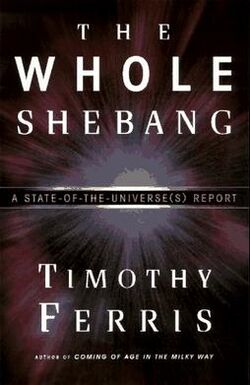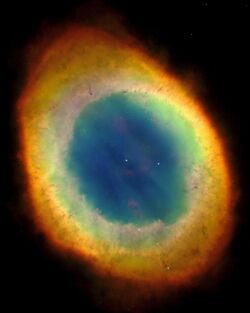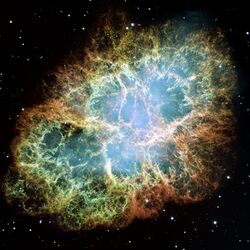Astronomy:The Whole Shebang: A State-of-the-Universe(s) Report
 First edition hardback cover | |
| Author | Timothy Ferris |
|---|---|
| Original title | The Whole Shebang: A State-of-the-universe(s) Report |
| Country | United States |
| Language | English |
| Subject | cosmology, science |
| Publisher | Simon & Schuster |
Publication date | 1997 |
| Media type | Print (Hardcover) |
| Pages | 400 |
| ISBN | ISBN:0-684-81020-4 |
| OCLC | 35990287 |
| 523.1 21 | |
| LC Class | QB981 .F38 1997 |
The Whole Shebang: A State-of-the-universe(s) Report is a 1997 science book by author Timothy Ferris.[1] In his book he provides a wide-range report of current research on cosmology, the study of the universe, and its trends going into the 21st century. He reports on theories about the possibility that our universe is one among many, the Big Bang theory, Black holes, the "expanding" universe, and "curved" space. The book has twelve chapters with most of it exploring the Big Bang theory and the mass density of the universe.[2]
Author
Ferris is a prizewinning author who has been called "the greatest science writer in the world."[3][4] He conceived and produced the Voyager phonograph record.[5] As a professor he has taught astronomy, English, history, journalism, and philosophy at four universities. Ferris has been nominated for the Pulitzer Prize in the category of general non-fiction for his physics and astronomy knowledge.
Quantum physics
He starts the book with quantum physics explaining Ω (dark matter and all mass density) and how it is measured. Cosmologists believe the universe is flat and that Ω equals one. They theorize the universe will continue expanding but at a slower and slower rate, never stopping completely. He explains that foundation models of the universe are not three-dimensional, but have a fourth spacetime continuum.[6] Ferris says cosmologist Andrei Linde estimates the radius of the universe to be an "astronomical" number of one followed by a trillion zeros centimeters.[7]
The book is an overview which examines mapping of large scale structures, weird quantum effects and cosmic evolution.[2] Ferris talks of black holes and what would happen if an astronaut jumped into one. He goes on to explain that a "boltzmon" is very small particle, but contains a galaxy's worth of information.[8] The book examines the pursuit of cosmologists to describe the universe conveniently in one mathematical formula,[9] a goal Albert Einstein was trying to achieve in his "unified theory."[10] The book also explains that virtually every society worldwide from ancient Egyptians to Native Americans to dwellers of modern cities have a supposition and hypothesis of the universe,[11] which ultimately influences their thinking consciously and subconsciously.[12]
Synthesis
Ferris explains in the beginning of his book the cosmological model as it has arrived to us today from ancient philosophy.[13] He then goes into quantum physics, deep explanations of the Big Bang Theory and that "space" and matter in the Big Bang theory were able to move faster than the speed of light. He further explains that "space" itself was being created at the same time as its astronomical objects therein. These objects and "space" together were expanding at this speed greater than light, at least for the first fraction of a second. Ferris writes for the reader to understand that "space" was created in the Big Bang and did not preexist. He explains that all "space" and matter in the universe were in a singularity before the Big Bang even started. This means a curvature of spacetime that's immeasurably large.[9][14]
He goes on to explain that in Albert Einstein's special theory of relativity, the rule that nothing can go faster than the speed of light, does not apply to galaxies in an expanding universe. He further explains that while that rule may apply in a preexisting static space, it does not apply in an expanding universe. In an expanding cosmic universe galaxies can travel away from each other at speeds in excess of the speed of light. As a result of this there are galaxies so far away that the light from them have not reached earth yet and therefore we don't even know they exist. Ferris refers to this phenomenon as a boundless steadily increasing and changing universe with a changing density.[15]
Ferris in his book explains the dynamism of the universe and the origins of chemical elements. He further examines the mystery of the clumping together of the stars within galaxies.[11] He gives an excerpt of the search for a Darwin type theory and explanation of the history of the universe. His research in how quantum mechanics works gives rise to why there may be many universes, not just one.[11] While some may shun away from what appears to be difficult scientific material, journalist Charles Krauthammer encourages non-technical people to read the book because it is as intuitive an account of its essential idea – the curvature of space – as I have ever read.[9]
Ferris uses most of his book searching for the cosmic mass density value of Ω. He points out that if Ω is a number under 1, the universe will expand forever. Contrary to this he shows that if Ω is a number greater than 1 then the universe will eventually collapse into itself in a "big crunch", the opposite of the Big Bang. Ferris then shows, in a third possibility, that the universe is hanging in the balance in a critical density that says Ω looks to be exactly 1.[2] Ferris makes the summation the universe will then always expand, but at a slower and slower rate that never completely comes to a halt.[2] He follows this up with some exceptions that Ω is not always observed as exactly 1 by all cosmologists.[16]
Ferris believes that the Big Bang theory is correct because of microwave background radiation which gives space a temperature of 3 kelvins. The Hubble Space Telescope has also shown, through the Doppler effect, that galaxies are moving away in proportion to their distances from Earth, which is evident by the redshift caused by lower frequencies generated from their normal frequency radiation. These detectable wavelength frequencies are at other than those of visible light. He explains in detail the Hubble constant, the ratio of the speed of a galaxy to its distance from earth.[1]
Ferris speculates that there is at least one, if not several, Black Holes in the middle of our own Milky Way galaxy. Visible light is unable to reach our telescopes from the center of the galaxy, so higher radio ways are used for "viewing." He suggests that by searching for Bekenstein-Hawking radiation then we might be able to find these Black Holes.[17]
According to Anthony Campbell's book review Ferris explains why cosmologists have their present-day philosophies. He points out that Ferris shows a mutual relationship between the very small and the very big. In the book the relativity specialists and the particle physicists seem to give rise to a universe that is from a single entity, a black hole perhaps. Ferris postulates that the strings of the superstring theory may be black holes.[18]
In the book Ferris gives a detailed account of dark matter, a mysterious component of the universe that influences the behavior of galaxies. Cosmologists have made note of five levels of structures larger than galaxies. These are the so-called galaxy groups and clusters, galaxy clouds, superclusters, and supercluster complexes. Ferris points out in his book that it appears unlikely that the universe has a fractal geometry, that is larger and larger structuring complexes, because of his theories behind dark matter.[18]
Ferris writes that the theory of a universe that expanded exponentially in the first fraction of a second may be one of the most productive thoughts in modern cosmology because it provides answers for many of the mysteries. He also writes of the state of the quantum theory to be indeterminate. Ferris tends to side with David Bohm's so called "hidden-variables" quantum theory in spite of the theoretical problems involved.[18]
Ferris admits that there is a tendency for descriptions of cosmology towards philosophy and also to lean towards theology. His theories lean towards the basis that the span of human being existence is part of the universe design. His views of God are not as taught in churches and synagogs but that the existence of the ultimate cause and the essential nature of things are really unknown. He points out that one can not support the personal theology theories of conventional religions against today's established principles of cosmology.[18] Ferris wraps up his book with intellectual arguments for God with his Contrarian Theological Afterword.[1]
Reviews
- Excellent ... a heroic synthesis of cosmic knowledge today. – Jim Holt, The Wall Street Journal .[19]
- An enjoyable and useful book, a heroic synthesis of cosmic knowledge today. – The Wall Street Journal.[20]
- A breathtakingly wide canvas ... Ferris is admirably lucid. – Owen Gingerich, The New York Times book review.[19]
- As the title implies, the topics covered in this book are nearly as vast and far reaching as the universe itself. The one constant, however, is that Ferris never strays too far from the central theme of the book, the big bang theory. This text has the potential to be a great asset to many science classrooms. The two concerns that I have, however, are in the level of complexity and the wide scope. Andrew Richardson, science student at Western Washington University.[21]
Sources
- ↑ 1.0 1.1 1.2 The Free Library book review
- ↑ 2.0 2.1 2.2 2.3 Book Review by Rohan Dowd
- ↑ Paperback book review
- ↑ Book description
- ↑ "Voyager Golden Record". http://www.timothyferris.com/other/#voyager.
- ↑ Ferris, p. 16
- ↑ Ferris, pp. 230–231
- ↑ Milo Miles book review
- ↑ 9.0 9.1 9.2 Journal Article Excerpt
- ↑ Ferris, pp. 104, 164, 205, 208, 229
- ↑ 11.0 11.1 11.2 A Review of General Semantics
- ↑ Ferris, p. 19
- ↑ Kirkus Reviews (March 15, 1997)
- ↑ Ferris, p. 17
- ↑ Ferris, pp. 40–43
- ↑ Ferris, pp. 16, 49, 51, 64, 65
- ↑ Ferris, pp. 96, 99, 103
- ↑ 18.0 18.1 18.2 18.3 Anthony Campbell book review
- ↑ 19.0 19.1 The whole shebang: a state-of-the-universe(s) report, back cover 1998 edition, ISBN:0-684-83861-3
- ↑ Book Report
- ↑ Western Washington University book review assignment
Bibliography
- Ferris, Timothy, The Whole Shebang: A State-of-the-universe(s) Report, Simon & Schuster, 1997, ISBN:0-684-81020-4
External links
- Weinberg, Steven (3 April 2015). "Steven Weinberg: the 13 best science books for the general reader". The Guardian. https://www.theguardian.com/books/2015/apr/03/steven-weinberg-13-best-science-books-general-reader. Retrieved 19 June 2015.




